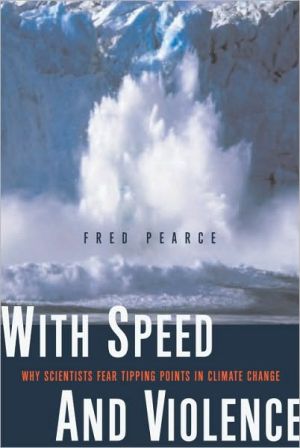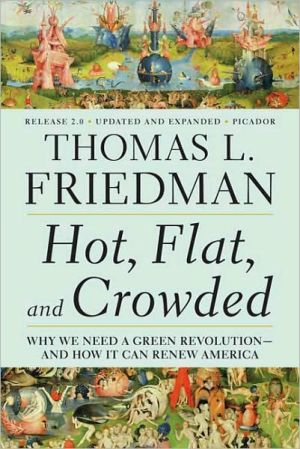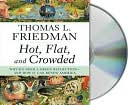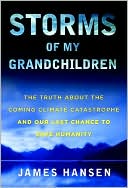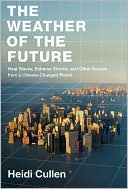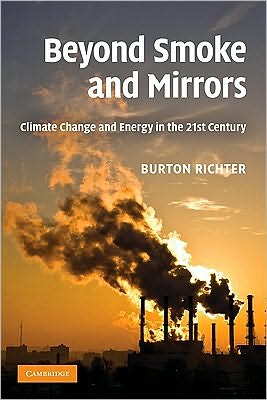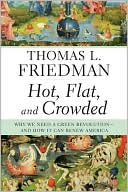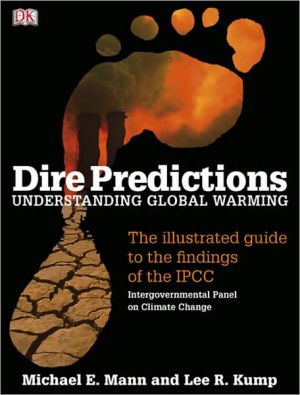With Speed and Violence: Why Scientists Fear Tipping Points in Climate Change
Nature is fragile, environmentalists often tell us. But the lesson of this book is that it is not so. The truth is far more worrying. Nature is strong and packs a serious counterpunch . . . Global warming will very probably unleash unstoppable planetary forces. And they will not be gradual. The history of our planet's climate shows that it does not do gradual change. Under pressure, whether from sunspots or orbital wobbles or the depredations of humans, it lurches-virtually overnight. —from...
Search in google:
Fred Pearce has been writing about climate change for twenty years, and the more he learns, the worse things look. As Pearce began researching this book, numerous scientists sought him out to recount their findings and fears: where once they were concerned about gradual climate change, many now worry that we will soon be experiencing abrupt change resulting from triggering tipping points. With Speed and Violence is the most up-to-date and readable book yet about the constantly accumulating evidence for global warming and the dramatic effects it may unleash."[Pearce's] grasp of [scientists'] work is exceptional. What's more, he has a talent for explaining science in terms understandable to the nonscientist . . . This enjoyable read was difficult to put down."—Library Journal, starred review "If you want to quickly get up to date on climate change and its consequences, I recommend With Speed and Violence. If you can read only one book on climate change, this is it."—Lester Brown, president, Earth Policy Institute Publishers Weekly Pearce (When the Rivers Run Dry) presents some climate modelers' frightening predictions about the consequences of increased global warming. After studying the history of the earth's climate changes, these scientists have learned that, under pressure from natural forces, major shifts can happen abruptly. Today, with the added stress of human interference, irreversible changes could threaten the habitability of our planet. For example, drought and fire could cause the Amazon rainforest to disappear; huge amounts of methane, a greenhouse gas that can be 100 times more powerful than carbon dioxide, could be released by the meltdown of Siberian peat; and aerosol emissions in India and China could end the indispensable Asian monsoon. Hard-line skeptics disagree, of course, but Pearce cites highly respected scientists who assert that the threats have been underestimated, especially by the U.N.'s Intergovernmental Panel on Climate Change. Even President Bush's chief climate modeler notes that the glaciers and ice sheets at the poles are disintegrating at alarming rates and warns that we may be only a decade and one degree of warming away from global catastrophe. The science behind climate studies is complex, but Pearce makes it accessible enough to terrify even the most uninitiated layperson. (Mar.) Copyright 2006 Reed Business Information.
WITH SPEED AND VIOLENCE\ Why Scientists Fear Tipping Points in Climate Change \ \ By Fred Pearce \ Beacon Press\ Copyright © 2007 Fred Pearce\ All right reserved.\ ISBN: 978-0-8070-8576-9 \ \ \ \ Chapter One\ THE PIONEERS \ The men who measured the planet's breath\ This story begins with a depressed Swedish chemist, alone in his study in the sunless Nordic winter after his marriage to his beautiful research assistant, Sofia, had collapsed. It was Christmas Eve. What would he do? Some might have gone out on the town and found themselves a new partner. Others would have given way to maudlin sentiment and probably a few glasses of beer. Svante Arrhenius chose neither release. Instead, on December 24, 1894, as the rest of his countrymen were celebrating, he rolled up his sleeves, settled down at his desk, and began a marathon of mathematical calculations that took him more than a year.\ Arrhenius, then aged thirty-five, was an obdurate fellow, recently installed as a lecturer in Stockholm but already gaining a reputation for rubbing his colleagues the wrong way. As day-long darkness gave way to months of midnight sun, he labored on, filling book after book with calculations of the climatic impact of changing concentrations of certain heat-trapping gases on every part of the globe. "It is unbelievable that so trifling a matter has cost me a full year," he later confided to a friend. But with his wife gone, he had few distractions. And the calculations became an obsession.\ What initially spurred his work was the urge to answer a popular riddle of the day: how the world cooled during the ice ages. Geologists knew by then that much of the Northern Hemisphere had for thousands of years been covered by sheets of ice. But there was huge debate about why this might have happened. Arrhenius reckoned that the clue lay in gases that could trap heat in the lower atmosphere, changing the atmosphere's radiation balance and altering temperatures.\ He knew from work half a century before, by the French mathematician Jean Baptiste Fourier and an Irish physicist called John Tyndall, that some gases, including carbon dioxide, had this heat-trapping effect. Tyndall had measured the effect in his lab. Put simply, it worked like this: the gases were transparent to ultraviolet radiation from the sun, but they trapped the infrared heat that Earth's surface radiated as it was warmed by the sun. Arrhenius reasoned that if these heat-trapping gases in the air decreased for some reason, the world would grow colder. Later dubbed "greenhouse gases," because they seemed to work like the glass in a greenhouse, these gases acted as a kind of atmospheric thermostat.\ Tyndall, one of the most famous scientists of his day and a friend of Charles Darwin's, had himself once noted that if heat-trapping gases were eliminated from the air for one night, "the warmth of our fields and gardens would pour itself unrequited into space, and the sun would rise upon an island held fast in the iron grip of frost." That sounded to Arrhenius very much like what had happened in the ice ages. Sure enough, when he emerged from his labors, he was able to tell the world that a reduction in atmospheric carbon dioxide levels of between a third and a half would cool the planet by about 8 degrees Fahrenheit-enough to cover most of northern Europe, and certainly every scrap of his native Sweden, in ice.\ Arrhenius had no idea if his calculations reflected what had actually happened in the ice ages. There could have been other explanations, such as a weakening sun. It was another eighty years before researchers analyzing ancient air trapped in the ice sheets of Greenland and Antarctica found that ice-age air contained just the concentrations of carbon dioxide that Arrhenius had predicted. But as he reached the end of his calculations, Arrhenius also became intrigued by the potential of rising concentrations of greenhouse gases, and how they might trigger a worldwide warming. He had no expectation that this was going to happen, but it was the obvious counterpart to his first calculation. And he concluded that a doubling of atmospheric carbon dioxide would raise world temperatures by an average of about 10°F.\ How did he do these calculations? Modern climate modelers, equipped with some of the biggest supercomputers, are aghast at the labor involved. But in essence, his methods were remarkably close to theirs. Arrhenius started with some basic formulae concerning the ability of greenhouse gases to trap heat in the atmosphere. These were off the shelf from Tyndall and Fourier. That was the easy bit. The hard part was deciding how much of the solar radiation Earth's surface absorbed, and how that proportion would alter as Earth cooled or warmed owing to changes in carbon dioxide concentrations.\ Arrhenius had to calculate many things. The absorption capacity of different surfaces across the globe varies, from 20 percent or less for ice to more than 80 percent for dark ocean. The capacities for dark forest and light desert, grasslands, lakes, and so on lie between these two extremes. So, armed with an atlas, Arrhenius divided the surface of the planet into small squares, assessed the capacity of each segment to absorb and reflect solar radiation, and determined how factors like melting ice or freezing ocean would alter things as greenhouse gas concentrations rose or fell. Eventually he produced a series of temperature predictions for different latitudes and seasons determined by atmospheric concentrations of carbon dioxide.\ It was a remarkable achievement. In the process he had virtually invented the theory of global warming, and with it the principles of modern climate modeling. Not only that: his calculation that a doubling of carbon dioxide levels would cause a warming of about 10°F almost exactly mirrors the Intergovernmental Panel on Climate Change's most recent assessment, which puts 10.4°F at the top of its likely warming range for a doubling of carbon dioxide levels.\ Arrhenius presented his preliminary findings, "On the Influence of Carbonic Acid in the Air upon the Temperature of the Ground," to the Stockholm Physical Society in December 1895 and, after further refinements, published them in the London, Edinburgh and Dublin Philosophical Magazine and Journal of Science. There he offered more predictions that are reproduced by modern computer models. High latitudes would experience greater warming than the tropics, he said. Warming would also be more marked at night than during the day, in winter than in summer, and over land than over sea.\ But he had cracked an issue that seemed to interest no one else. The world forgot all about it. Luckily for Arrhenius, this labor was but a sideshow in his career. A few years after completing it, he found fame as the winner of the 1903 Nobel Prize for Chemistry, for work on the electrical conductivity of salt solutions. Soon, too, he had a new wife and a child, and other interests-he dabbled in everything from immunology to electrical engineering. He was an early investigator of the northern lights and a popular proponent of the idea that the seeds of life could travel through space.\ But after the First World War, his mood changed. The optimism of his generation, which believed that science and technology could solve every problem, crumbled in the face of a war that killed so many of its sons. He railed against the wastefulness of modern society. "Concern about our raw materials casts a dark shadow over mankind," he wrote, in an early outburst of twentieth century environmental concern. "Our descendants surely will censure us for having squandered their just birthright." His great fear was that oil supplies would dry up, and he predicted that the United States might pump its last barrel as early as 1935. He advocated energy efficiency and proposed the development of renewable energy, such as wind and solar power. He sat on a government commission that made Sweden one of the first countries to develop hydroelectric power.\ Many Swedes today see Arrhenius as an environmental pioneer and praise his efforts to promote new forms of energy. He would have been bemused by this appreciation. For one thing, he never made the connection between his work on the greenhouse effect and his later nightmares about disappearing fossil fuels. He knew from early on that burning coal and oil generated greenhouse gases that would build up in the air. But he rather liked the idea, writing in 1908: "We may hope to enjoy ages with more equable and better climates, especially as regards the colder regions of the Earth, ages when the Earth will bring forth much more abundant crops for the benefit of a rapidly propagating mankind." But he had concluded with some sadness that it would probably take a millennium to cause a significant warming. And when he later began to perceive the scale of industrial exploitation of fossil fuels, his fear was solely that the resources would run out.\ For half a century after Arrhenius's calculations, the prevailing view continued to be that man-made emissions of carbon dioxide were unlikely to have a measurable effect on the climate anytime soon. Nature would easily absorb any excess. From time to time, scientists did measure carbon dioxide in the air, but local variability was too great to identify any clear trends in concentrations of the gas.\ The only man to take the prospect of greenhouse warming seriously was a British military engineer and amateur meteorologist, Guy Callendar. In a lecture at the Royal Meteorological Society in 1938, he said that the few existing measurements of carbon dioxide levels in the atmosphere suggested a 6 percent increase since 1900, that this must be due to fossil fuel burning, and that the implication was that warming was "actually occurring at the present time." Like Arrhenius, Callendar thought this on balance rather a good thing. And like Arrhenius, he saw his findings pretty much ignored.\ The next person to make a serious effort was Charles David Keeling, a young student at the Scripps Institution of Oceanography, in La Jolla, California. He began monitoring carbon dioxide levels in the mid-1950s, first in the bear-infested hills of the state's Yosemite National Park, where he liked to go hiking, and later, in the hope of getting better data, in the clean air 14,000 feet up on top of Mauna Loa, a volcano in Hawaii. Keeling took measurements every four hours on Mauna Loa, in the first attempt ever to monitor carbon dioxide levels in one place continuously. He was so serious about his measurements that he missed the birth of his first child in order to avoid any gaps in his logbook.\ The results created a sensation. Keeling quickly established that in such a remote spot as Mauna Loa, above weather systems and away from pollution, he could identify a background carbon dioxide level of 315 parts per million (ppm). The seasonal cycling of carbon dioxide caused an annual fluctuation around this average between summer and winter. Plants and other organisms that grow through photosynthesis consume carbon dioxide from the air, especially in spring. But during autumn and winter, photosynthesis largely stops, and the photosynthesizers are eaten by soil bacteria, fungi, and animals. They exhale carbon dioxide, pushing atmospheric levels back up again. Because most of the vegetation on the planet is in the Northern Hemisphere, the atmosphere loses carbon dioxide in the northern summer and gains it again in the winter. Earth, in effect, breathes in and out once a year.\ But Keeling's most dramatic discovery was that this annual cycle was superimposed on a gradual year-to-year rise in atmospheric carbon dioxide levels-a trend that has become known as Keeling's curve. The background concentration of 315 ppm that Keeling found on Mauna Loa in 1958 has risen steadily, to 320 ppm by 1965, 331 ppm by 1975, and 380 ppm today.\ The implications of Keeling's curve were profound. "By early 1962," he later wrote, "it was possible to deduce that approximately half of the C[O.sub.2] from fossil fuel burning was accumulating in the air," with the rest absorbed by nature. By the late 1960s he had noticed that the annual cycling of carbon dioxide was growing more intense. And the spring downturn in atmospheric levels was beginning earlier in the year-strong evidence that the slow annual increase in average levels was raising temperatures and creating an earlier spring.\ Keeling personally supervised the meticulous measurements on Mauna Loa until his death, in 2005. In his final year, this generally mild man picked up the public megaphone one last time to warn that, for the first time in almost half a century, his instruments had recorded two successive years, 2002 and 2003, in which background carbon dioxide levels had risen by more than 2 ppm. He warned that this might be because of a weakening of the planet's natural ability to capture and store carbon in the rainforests, soils, and oceans-nature's "carbon sinks." He feared that nature, which had been absorbing half the carbon dioxide emitted by human activity, might be starting to give it back-something that, in his typically understated way, he suggested "might give cause for concern."\ On his death, Keeling's bosses at Scripps were kind enough to call the Keeling curve "the single most important environmental data set taken in the 20th century." Nobody disagreed. One writer called him the man who "measured the breathing of the world."\ Thanks to Keeling's curve, the ideas of Arrhenius and Callendar were rescued from the dustbin of scientific history. It seemed he was right that people could tamper with the planetary thermostat. Climatologists, many of whom had predicted in the 1960s that natural cycles were on the verge of plunging the world into a new ice age, began instead to warn of imminent man-made global warming. As late as the early 1970s, U.S. government officials had been asking their scientists how to stop the Arctic sea ice from becoming so thick that nuclear submarines could not break through. But by the end of the decade, President Jimmy Carter's Global 2000 Report on the environment had identified global warming as an urgent new issue, and the National Academy of Sciences had begun the first modern study of the problem.\ A vast amount of research has been conducted since. For the past decade and a half, the IPCC has produced regular thousand-page updates just to review the field and pronounce on the scientific consensus. But in some ways, mainstream thinking on how climate will alter as carbon dioxide levels rise has not advanced much in the century since Arrhenius. Thanks to Keeling, we know that those levels are rising; but little else has changed.\ Only in the past five years, as researchers have learned more about the way our planet works, have some come to the conclusion that changes probably won't be as smooth or as gradual as those imagined by Arrhenius-or as the scenarios of gradual change drawn up by the IPCC still suggest. We are in all probability already embarked on a roller-coaster ride of lurching and sometimes brutal change. What that ride might feel like is the central theme of this book.\ Chapter Two\ TURNING UP THE HEAT \ A skeptic's guide to climate change\ Ever since the rise of concern about climate change during the 1980s, the scientists involved have been dogged by a small band of hostile critics. Every time they believe they have seen them off, the skeptics come right back. And in some quarters, their voices remain influential. One leading British newspaper in 2004 called climate change a "global fraud" based on "left-wing, anti-American, anti-West ideology." And the best-selling author Michael Crichton, in his much-publicized novel State of Fear, portrayed global warming as an evil plot perpetrated by environmental extremists.\ Many climate scientists dismiss the skeptics with a wave of the hand and return to their computer models. Most skeptics, they note, fall into one of three categories: political scientists, journalists, and economists with little knowledge of climate science; retired experts who are aggrieved to find their old teachings disturbed; and salaried scientists with overbearing bosses to serve, such as oil companies or the governments in hock to them. If the skeptics are to be believed, the evidence for global warming and even the basic physics of the greenhouse effect are full of holes. The apparent scientific consensus exists only, they say, because it is enforced by a scientific establishment riding the gravy train, aided and abetted by politicians keen to play the politics of fear. Much of this may sound hysterical. But could the skeptics be on to something.\ (Continues...)\ \ \ \ \ Excerpted from WITH SPEED AND VIOLENCE by Fred Pearce Copyright © 2007 by Fred Pearce. Excerpted by permission.\ All rights reserved. No part of this excerpt may be reproduced or reprinted without permission in writing from the publisher.\ Excerpts are provided by Dial-A-Book Inc. solely for the personal use of visitors to this web site. \ \
Chronology of Climate Change xiThe Cast xvPreface to the Paperback Edition xixPreface: The Chimney xxiiiIntroduction xxviiWelcome to the AnthropoceneThe Pioneers: The men who measured the planet's breath 3Turning Up the Heat: A skeptic's guide to climate change 10The Year: How the wild weather of 1998 broke all records 18The Anthropocene: A new name for a new geological era 21The Watchtower: Keeping climate vigil on an Arctic island 26Fault lines in the iceNinety Degrees North: Why melting knows no bounds in the far North 35On the Slippery Slope: Greenland is slumping into the ocean 39The Shelf: Down south, shattering ice uncorks the Antarctic 46The Mercer Legacy: An Achilles heel at the bottom of the world 49Rising Tides: Saying "toodle-oo" to Tuvalu 55Riding the carbon cycleIn The Jungle: Would we notice if the Amazon went up in smoke? 63Wildfires of Borneo: Climate in the mire from burning swamp 68Sink to Source: Why the carbon cycle is set for a U-turn 71The Doomsday Device: A lethal secret stirs in the permafrost 77The Acid Bath: What carbon dioxide does to the oceans 86The Winds of Change: Tsunamis, megafarts, and mountains of the deep 90Reflecting on warmingWhat's Watts?: Planet Earth's energy imbalance 101Clouds From Both Sides: Uncovering flaws in the climate models 105A Billion Fires: How brown haze could turn off the monsoon 115Hydroxyl Holiday: The day the planet's cleaner didn't show up for work 120Ice ages and solar pulsesGoldilocks and the Three Planets: Why Earth is "just right" for life 127The Big Freeze: How a wobble in our orbit triggered the ice ages 132The Ocean Conveyor: The real day after tomorrow 141An Arctic Flower: Clues to a climate switchback 148The Pulse: How the sun makes climate change 155Tropical heatThe Fall: The end of Africa's golden age 167Seesaw Across the Ocean: How the Sabara Desert greens the Amazon 175Tropical High: Why an ice man is rewriting climate history 178The Curse of Akkad: The strange revival of environmental determinism 185A Chunk of Coral: Probing the hidden life of El Nino 188Feeding Asia: What happens if the monsoon falters? 194At the millenniumThe Heat Wave: The year Europe felt the heat of global warming 201The Hockey Stick: Why now really is different 204Hurricane Season: Raising the storm cones after Katrina 210Ozone Holes in the Greenhouse: Why millions face radiation threat 217Inevitable surprisesThe Dance: The poles or the tropics? Who leads in the climatic dance? 225New Horizons: Feedbacks from the stratosphere 229Conclusion: Another Planet 237The Trillion-Ton Challenge 241Glossary 253Acknowledgments 259Notes on the References 261Index 273
\ Publishers WeeklyPearce (When the Rivers Run Dry) presents some climate modelers' frightening predictions about the consequences of increased global warming. After studying the history of the earth's climate changes, these scientists have learned that, under pressure from natural forces, major shifts can happen abruptly. Today, with the added stress of human interference, irreversible changes could threaten the habitability of our planet. For example, drought and fire could cause the Amazon rainforest to disappear; huge amounts of methane, a greenhouse gas that can be 100 times more powerful than carbon dioxide, could be released by the meltdown of Siberian peat; and aerosol emissions in India and China could end the indispensable Asian monsoon. Hard-line skeptics disagree, of course, but Pearce cites highly respected scientists who assert that the threats have been underestimated, especially by the U.N.'s Intergovernmental Panel on Climate Change. Even President Bush's chief climate modeler notes that the glaciers and ice sheets at the poles are disintegrating at alarming rates and warns that we may be only a decade and one degree of warming away from global catastrophe. The science behind climate studies is complex, but Pearce makes it accessible enough to terrify even the most uninitiated layperson. (Mar.) Copyright 2006 Reed Business Information.\ \ \ \ \ Library JournalThis book looks at our current understanding of how our planet's climate changes over time. Pearce (environment & development consultant, New Scientist; When the Rivers Run Dry) has been writing about climate change for 18 years, during which time he has interviewed scientists researching the phenomenon. His grasp of their work is exceptional. What's more, he has a talent for explaining science in terms understandable to the nonscientist. He explains many scientific discoveries and theories, noting how they interweave into the fabric of our understanding of how the climate has changed in the past—and how it may change in the future. Hovering throughout is the question of how much of the current global warming is natural and how much of it is magnified by human activities. Apparently, there are tipping points after which the climate changes will occur quickly and will not be correctable by human efforts. This enjoyable read was difficult to put down. A superb educational resource, it will make an excellent addition to any public library and is recommended as an essential purchase for high school, college, and university libraries.\ —Betty Galbraith\ \ \ Kirkus ReviewsWell-documented and terrifying review of the scientific evidence supporting claims that Earth teeters on the edge of a climactic precipice. Pearce (When the Rivers Run Dry, 2006, etc.) begins by dismissing the argument that global-warming claims are "empty rhetoric." Each ensuing chapter describes a specific tipping point-an indicator that dramatic climate change may be around the corner, possibly occurring within the next decade. Along the way, we learn about the ozone, greenhouse gases and phenomena such as Arctic Sea "chimneys." Particularly compelling is Pearce's explanation of why aspects of the Kyoto Protocol, designed to offset global warming, may actually have the opposite effect in Arctic regions. The author profiles scientists and weaves personal anecdotes into his narrative. The weighty and highly technical information in his research-laden text, though laid out in clear prose, at times becomes cumbersome for the layperson. In the end, however, the abundance of facts substantively bolsters Pearce's contention that the end of the world as we know it may be nigh. Important reading for policymakers, climate-change skeptics and anyone planning a future beyond the next decade.\ \
